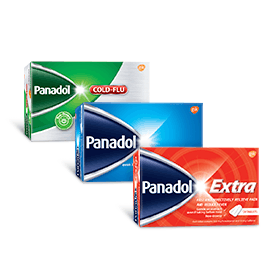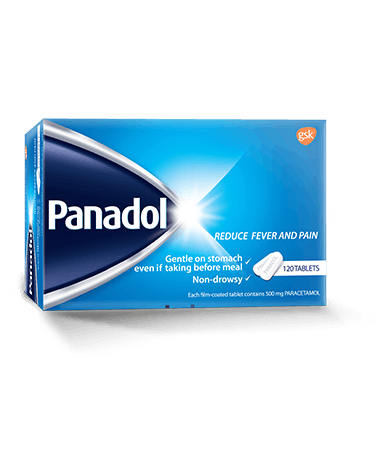Panadol 500 mg
Indications
Paracetamol is an analgesic and an antipyretic. Treatment of miId-to-moderate pain and treatment of fever including:
- Headache
- Migraine
- Muscle ache
- Dysmenorrhoea
- Sore throat
- Musculoskeletal pain
- Fever and pain associated with vaccination/immunisation
- Pain after dental procedures / tooth extraction
- Toothache
- Earache / otalgia
- Respiratory tract infections including cold and flu
- Osteoarthritis pain.
PHARMACEUTICAL FORM
Tablets.
PACK SIZE
Box of 10 blisters x 12 tablets.
COMPOSITION
Each film-coated tablet contains:
Active ingredients:
Paracetamol ................... 500 mg
Excipients:
Pregelatinised Starch, Maize Starch, Povidone, Potassium Sorbate, Talc, Stearic Acid,
Hydroxypropyl Methylcellulose (HPMC), Triacetin.
CONTRA-INDICATIONS
This product is contraindicated in patients with a previous history of hypersensitivity to paracetamol or excipients.
- Read more
- Read less
DOSAGE AND ADMINISTRATION
Do not exceed the stated dose.
The lowest dose necessary to achieve efficacy should be used for the shortest duration of treatment.
Oral administration only.
Children aged 7 to 12 years can take half to 1 caplet every 4-6 hours with water, as required. Do not exceed the maximum of 4 caplets in a 24-hour period. Do not use for more than 48 hours except on medical advice.i
Panadol Caplets with OPTIZORB Formulation are not recommended for use in children aged under 7 years.i
Minimum dosing interval: 4 hours.
Maximum daily dose: 4000 mg.
Adults (including the elderly) and children aged 12 years and over:
500 mg to 1000mg paracetamol (1 to 2 tablets), taken every 4 to 6 hours as required.
Children, 6 to 11 years:
No more than four doses in any 24-hour period.
Maximum duration of continued use without medical advice: 3 days.
Maximum daily dose: 60 mg/kg to be administered in divided doses of 10-15 mg/kg throughout the 24-hour period.
6-8 years: 250 mg (½ tablet).
9-11 years: 500 mg paracetamol (tablet).
Children under 6 years:
Not recommended for children under the age of 6 years.
- Read more
- Read less
More Information
- Contains paracetamol. Do not use with any other paracetamol-containing products. The concomitant use with other products containing paracetamol may lead to an overdose.
- Paracetamol overdose may cause liver failure which may require liver transplant or lead to death.
- Underlying liver disease increases the risk of paracetamol-related liver damage. Patients who have been diagnosed with liver or kidney impairment must seek medical advice before taking this medication.
- Cases of hepatic dysfunction /failure have been reported in patients with depleted glutathione levels, such as those who are severely malnourished, anorexic, have a low body mass index, are chronic heavy users of alcohol or have sepsis.
- In patients with glutathione depleted states, the use of paracetamol may increase the risk of metabolic acidosis.
- If symptoms persist, medical advice must be sought.
- Keep out of sight and reach of children.
The anticoagulant effect of warfarin and other coumarins may be enhanced by prolonged regular daily use of paracetamol with increased risk of bleeding; occasional doses have no significant effect.
Pregnancy
As with the use of any medicine during pregnancy, pregnant women should seek medical advice before taking paracetamol. The lowest effective dose and shortest duration of treatment should be considered.
Lactation
Paracetamol is excreted in breast milk but not in a clinically significant amount at recommended dosages. Available published data do not contraindicate breastfeeding.
ADVERSE REACTIONS
Adverse events from historical clinical trial data are both infrequent and from small patient exposure. Accordingly, events reported from extensive post-marketing experience at therapeutic/labeled dose and considered attributable are tabulated below by System Organ Class and frequency. The following convention has been utilized for the classification of undesirable effects: very common (≥1/10), common (≥1/100, <1/10), uncommon (≥1/1,000, <1/100), rare (≥1/10,000, <1/1000), very rare (<1/10,000), not known (cannot be estimed from available data). Adverse event frequencies have been estimated from spontaneous reports received through post-marketing data.
Post Marketing Data
| Body System | Undesirable Effects | Frequency |
| Blood and lymphatic system disorders |
Thrombocytopaenia | Very rare |
| Immune System disorders |
Anaphylaxis, cutaneous hypersensitivity reactions including, among others, skin rashes, angioedema, Stevens -Johnson syndrome and Toxic Epidermal Necrolysis. | Very rare |
| Respiratory, thoracic and mediastinal disorders | Bronchospasm in patients sensitive to aspirin and other NSAIDs | Very rare |
| Hepatobiliary disorders | Hepatic dysfunction | Very rare |
Related Articles
Discover the full range of Panadol everyday pain relief products today
Always read the label before use.
If you want to get a superior quality medicine, please purchase medicine with certified stamp register number CAM R4 2712 IP-04 (Panadol 500), CAM R2 0011 IP-10 (Panadol Extra), CAM R2 0012 IP-10 (Panadol Cold&Flu) in pharmacy and sub-pharmacy with permits and logo issued by the ministry of Health. The advertisement is already approved by Health Authority. If any side effect from using this medicine, please report to department of Medicine via telephone no. 012 673 268/ 089 498 883 or Email pv.center@ezecome.com.kh or Website https://www.ddfcambodia.com/ and Contact Number from DKSH Company DKSH 067 555 752










